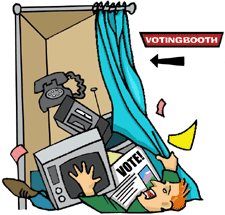One Journalist's View: Informed Voters Must Reach Beyond Images
|
This article originally appeared in Issue# 44
|
A major complaint often heard about the coverage of any campaign is, "Why don't they cover the issues? As a reporter, I would argue that we do, but our audience doesn't focus on them. Journalists covering any campaign will hear and report the same speech endlessly. The good ones will run issues pieces as well. But people tend to pay the most attention to personality stories, character confrontations and the final horse race. The process results in a constant search by reporters for the different and unusual-and often that proves to be not significant.
As a radio reporter and thus in a competing medium, I'm often asked whether I feel TV's political reporting is too visual. The answer is yes - but there's no way around it. A colleague told me about an event she covered during the l980 Reagan campaign that featured fireworks in the middle of the day. She wondered what was going on until she saw that the fireworks turned into millions of tiny American flags. It was just a gorgeous picture.
Pictures form such a strong image in voters' minds that they've become a requirement for every candidate. No one will be able to say "Well, I just wasn't good on TV." They'll have to get good.
At times people do not really hear what is said on television - they see it. But no candidate can ignore television's role as the major source of news for most people. In one way this makes sense. The president has to use television to ask people to do the hard things - to pay higher taxes, to send their children to war. They will respond to a president who gives them a sense of confidence and inspires them. In the latter part of the 20th Century the medium for doing that is television.
I don't agree with analysts who complain that politics is becoming a spectator sport, with people staying at home to watch the result of other citizens' votes. People will turn out when they have something they want to vote for. Turnout on Super Tuesday this year, for example, was way up.
Our highest voter turnout was in the presidential balloting in 1960, a very close election. Voters cast their ballots at a lower  rate both before and after. In my view the low voter turnout of the last 20 years is related to the baby boom's coming of age. Its members became voters just as the voting age was lowered to I8. We thus had this huge group of newly eligible youthful voters who weren't voting because they were younger than the age at which most people tend to vote.
rate both before and after. In my view the low voter turnout of the last 20 years is related to the baby boom's coming of age. Its members became voters just as the voting age was lowered to I8. We thus had this huge group of newly eligible youthful voters who weren't voting because they were younger than the age at which most people tend to vote.
In general, people who don't feel they have a stake in the process don't see the point of voting. Often nonvoters are from lower income, and less educated groups. In the past, they were also apt to be female. But today, women, who for a long time thought they couldn't make a difference, are turning out in huge numbers. In 1980, for the first time, there were as many women voting as men. The trend continued, and in 1986, nine million more women voted than men. If people are given the incentive and are really being organized to get to the polls, they will vote.
The key to making the public politically active is to make sure it's well-informed. Major newspapers and magazines, as well as radio and television, all provide a wealth of resources.
Put another way, we've had an explosion in information. No one can complain, "Oh, I wanted to know and there was no way of finding out," It's just that you might not be able to inform yourself completely by sitting in your living room and turning on the television set.
"When George Washington wrote his famous farewell address, he included a paragraph complaining about treatment from the media. It was edited out upon advice from George Hamilton."— James David Barber



